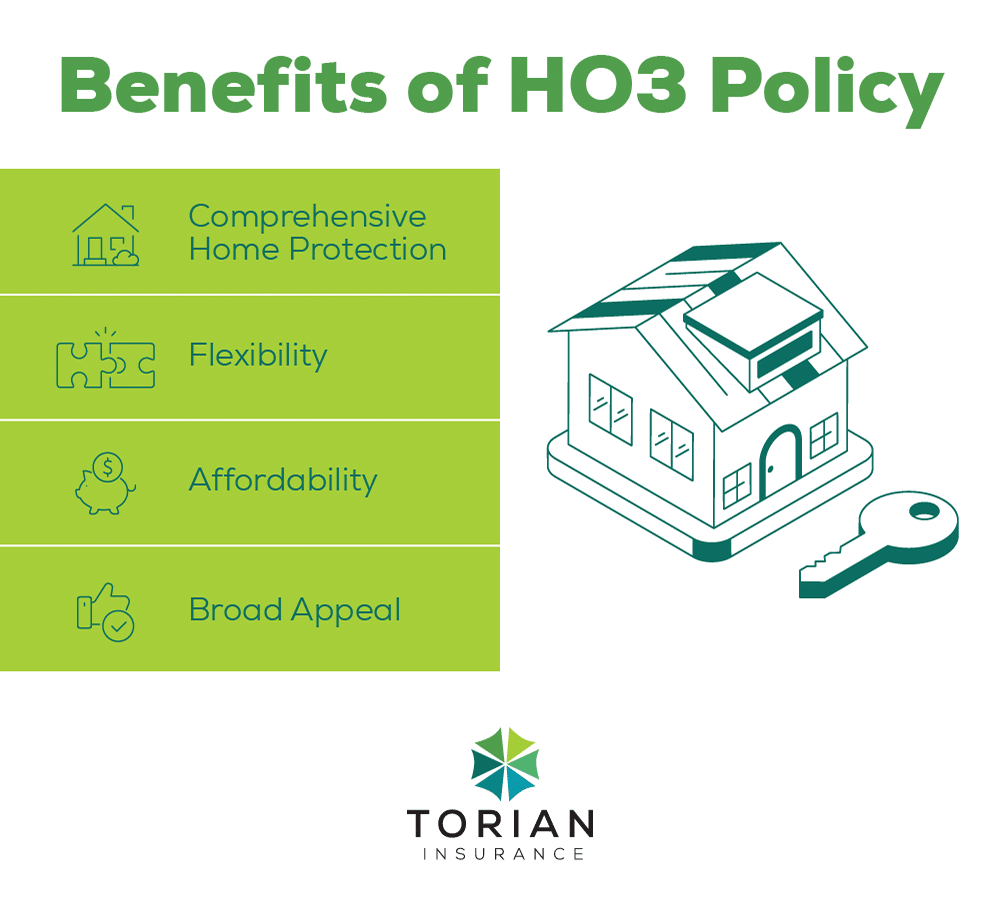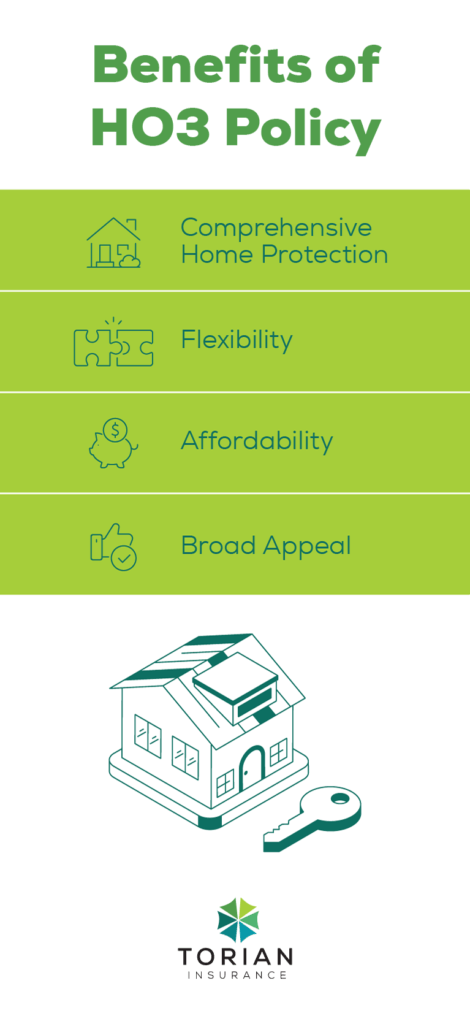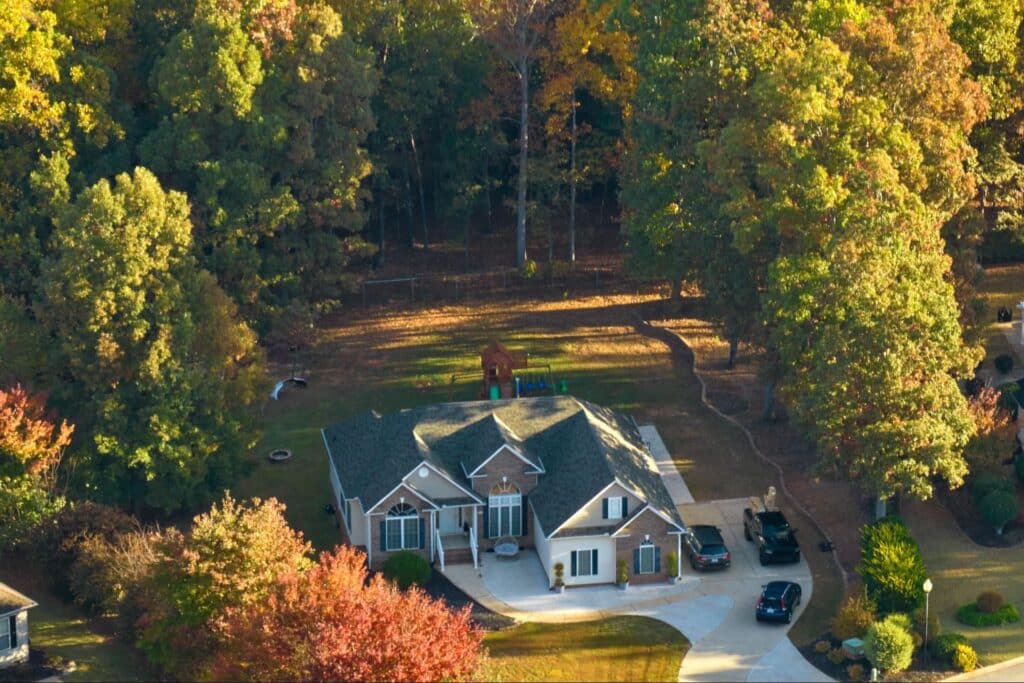HO3 homeowners insurance is one of the most popular policies among American homeowners. If you own a home in Southern Indiana, Illinois, or Kentucky—or plan to purchase one—this versatile HO3 policy provides robust protection for your property and personal belongings while offering a balanced mix of coverage and cost. Premiums and rates can vary based on individual circumstances, so it’s important to understand how an HO3 policy works, its key coverage areas, and the advantages of working with an independent insurance agency like Torian Insurance.
From outlining the basic structure and benefits of an HO3 policy to discussing options for customization and avoiding common mistakes, this guide helps you secure the right coverage for your most valuable asset. HO3 policies cover a wide range of risks, which can be especially valuable for homeowners in the Midwest, where unpredictable weather patterns may affect property. Additionally, homeowners may need to consider local building codes, the prevalence of storms or tornadoes, and other factors unique to Southern Indiana, Illinois, and Kentucky.
What Is an HO3 Homeowners Insurance Policy?
An HO3 policy, often called a “special form policy,” is designed for owner-occupied homes and townhouses. It provides open-perils protection for your home’s structure—covering any damage unless explicitly excluded—while insuring personal belongings on a named-perils basis. This mix of coverage allows homeowners to protect their property with extensive dwelling coverage and more specific protection for personal items, making it a popular choice for balancing robust coverage with cost considerations.
Why Is the HO3 Policy So Popular?


The HO3 policy is favored because it offers:
- Comprehensive Home Protection: Open-perils coverage protects your property against most risks.
- Flexibility: The policy can be customized with endorsements to cover unique risks.
- Affordability: It provides a balance between extensive protection and reasonable pricing, though exact costs depend on individual factors.
- Broad Appeal: Ideal for both first-time and experienced homeowners due to its adaptable structure.
A practical example is a homeowner in Evansville who experiences hail damage to the roof. Because the dwelling is protected on an open-perils basis, this type of damage—unless specifically excluded—would typically be covered, minus any deductible. The ability to adapt an HO3 policy to include or enhance coverage for such events makes it a logical choice for a broad range of homeowners.
Key Coverage Areas in an HO3 Policy
Understanding the specific components of an HO3 policy is crucial to ensuring it meets your needs. Each coverage area works together to protect both the physical structure of your home and your personal finances in the event of a loss.
Dwelling Coverage
Dwelling coverage (Coverage A) protects the physical structure of your home, including attached structures like garages or porches. Covered on an open-perils basis, it insures against any damage not specifically excluded from the policy. For instance, if your region faces windstorms or unexpected hail—common in parts of the Midwest—having sufficient dwelling coverage is crucial. Remember that floods and earthquakes usually require separate coverage.
Other Structures Coverage
Other structures coverage (Coverage B) extends protection to detached structures on your property such as sheds or fences. This coverage follows an open-perils model, offering protection against most risks. If, for example, a detached garage or workshop sustains storm damage, you can be compensated for repairs or rebuilding, depending on your coverage limits and specific exclusions.
Personal Property Coverage
Personal property coverage (Coverage C) protects the contents of your home—furniture, electronics, clothing, and more—on a named-perils basis. It’s wise to review the listed perils in your policy and consider scheduling any high-value items that exceed standard limits. As an example, if you have valuable antiques or high-end electronics, you might need an endorsement for sufficient coverage. Keeping an updated inventory of your possessions is a good practice to expedite any future claims.
Loss of Use Coverage
Loss of use coverage (Coverage D) – also known as additional living expenses – helps pay for temporary housing and other costs if your home becomes uninhabitable due to a covered loss. If a disaster forces you out of your home for a few weeks, this coverage can pay for hotel bills, food, and other necessary expenses, alleviating stress during a difficult time.
Liability Coverage
Liability coverage (Coverage E) safeguards you against financial losses arising from injuries or property damage caused by you or a family member. It covers legal fees, medical expenses, and potential settlements, helping reduce the financial impact of unexpected incidents. This is especially important if you often host gatherings or have features like a swimming pool or trampoline that increase the chance of accidents.
Medical Payments Coverage
Medical payments coverage (Coverage F) handles minor medical expenses if a guest is injured on your property, regardless of fault. This coverage offers quick financial assistance for small claims, allowing you to avoid prolonged disputes and maintain good relationships with neighbors, friends, or visitors.
Common Exclusions and Limits
Standard HO3 policies exclude certain risks such as:
- Flood Damage: Usually requires separate flood insurance.
- Earthquake Damage: Often excluded but can be added as an endorsement.
- Sewer Backup and Maintenance Issues: May need additional or specialized endorsements.
- Government seizure, demolition or requirement to rebuild to match building codes
- Earth movements: including earthquakes, sinkholes and landslides
- Power failure: (if the source of failure is off-site)
- Homeowner neglect
- War and nuclear hazards
It’s important to understand these exclusions so you can decide whether additional coverage—like flood or earthquake protection—might be necessary, especially if you live near rivers, low-lying areas, or any seismically active zones.
Benefits of an HO3 Policy for Homeowners
An HO3 policy offers several advantages that make it a practical choice:
Comprehensive Structural Protection
Open-perils coverage for your home’s structure safeguards against a broad range of risks, giving you confidence to repair or rebuild after a covered event. This capability is valuable across the tri-state region, where weather events can be unpredictable and stressful.
Financial Security
By providing resources to rebuild or replace damaged structures and items, the HO3 policy lessens the financial burden of unexpected losses. For instance, if a major storm damages your roof or a fire destroys part of your home, your policy helps you regain stability without depleting your savings.
Cost-Effective Coverage
By combining expansive protection for your dwelling with selected coverage for personal property, the HO3 policy offers a practical balance between comprehensive coverage and affordability. Homeowners on a tight budget can still protect their biggest investment without incurring the higher premiums associated with more specialized policy forms.
Built-in Liability and Flexibility
With built-in liability coverage and the option to add endorsements, the HO3 policy adapts to different homeowner needs. You can address specific risks like sewer backup or ordinance or law upgrades, ensuring the policy is well-suited to your particular home and lifestyle.
Peace of Mind
Having an HO3 policy means knowing your home and personal assets are protected so you can focus on daily life without worrying about coverage gaps. Whether you’re planning a remodel or simply want to ensure your home is safe from day-to-day hazards, the HO3 policy provides a reliable safety net.
For example, if you add a new deck or renovate your kitchen, upgrading your coverage can be done smoothly with a simple conversation with your agent. Ensuring your new investments are protected can help you avoid costly out-of-pocket expenses later on.
Customization Options for HO3 Policies
Every homeowner has unique needs, and customization ensures your insurance policy addresses your specific risks and property details.
Why Customization Matters
Tailoring your policy can cover local risks and protect high-value items or specialized structures. Some factors to consider:
- Location-Specific Risks: In flood-prone areas, adding flood insurance is critical.
- High-Value or Unique Items: Scheduling coverage for jewelry, artwork, or collectibles helps avoid underinsurance.
- Extra Protections for Outbuildings: Additional endorsements can extend coverage to detached structures or home expansions.
If you live in an area with older infrastructure, for instance, you might want to discuss sewer backup coverage. Alternatively, if you’ve invested in solar panels, you can explore specific endorsements that protect those installations. By customizing your policy, you ensure your home is shielded from threats that other standard policies might overlook.
Popular Add-Ons
- Earthquake Coverage: Useful in seismic regions; explore earthquake coverage.
- Sewer Backup Coverage: Homes with older plumbing can benefit from sewer backup coverage.
- Scheduled Personal Property: For high-value items, a scheduled personal property endorsement can fill coverage gaps.
- Ordinance or Law Coverage: Helps pay for costs to meet updated codes.
Comparing HO3 Policies with Other Homeowners Insurance Options
Unlike more basic policies (HO1 and HO2) that cover a limited list of perils, the HO3 offers open-perils protection for your home. It also provides a more balanced alternative to premium options like HO5, which, although offering broader coverage, typically come at higher prices. For most homeowners, the HO3 policy delivers comprehensive protection at an affordable rate.
Homeowners seeking to protect an older or historic dwelling might consider HO8 if the building materials are difficult to replace. However, for many modern homes in Southern Indiana, Illinois, and Kentucky, the HO3’s versatility is often the best fit, balancing coverage needs and budget considerations.
| Policy Type | Form Name | Property Covered | Dwelling Coverage Basis | Personal Property Coverage Basis | Ideal For / Description |
| HO1 | Basic Form | Dwelling, Other Structures (Limited) | Named Perils | Often Excluded | Offers the most limited coverage, typically covering only 10 specific perils. Not available in many states and often not accepted by lenders |
| HO2 | Broad Form | Dwelling, Other Structures, Personal Property | Named Perils | Named Perils | Covers the 10 perils in HO1 plus several more, usually totaling around 16 perils. Broader than HO1 but still limited compared to HO3 or HO5. |
| HO3 | Special Form | Dwelling, Other Structures, Personal Property | Open Perils | Named Perils | The most common type for owner-occupied houses. Provides extensive coverage for the dwelling structure and named-perils coverage for belongings. |
| HO4 | Tenant’s Form | Personal Property, Liability | Not Applicable | Named Perils | Designed for renters, covering their personal belongings and liability, but not the building structure. |
| HO5 | Comprehensive Form | Dwelling, Other Structures, Personal Property | Open Perils | Open Perils | Offers the broadest coverage, protecting both the dwelling and personal property against all perils except those specifically excluded. Often includes replacement cost for contents. |
| HO6 | Condo Form | Interior of Unit (“Walls-In”), Personal Property | Named Perils | Named Perils | Tailored for condo owners, covering the interior structure of the unit, personal property, and liability The exterior and common areas are typically covered by the HOA’s master policy. |
| HO7 | Mobile Home Form | Mobile Home Structure, Personal Property | Modified Named Perils | Modified Named Perils | A modified version of the HO2 policy designed specifically for mobile homes. Covers the mobile home structure and personal property. |
| HO8 | Modified Coverage | Dwelling, Other Structures, Personal Property | Named Perils | Named Perils | Designed for older homes (often historic or those where replacement cost exceeds market value). Provides named-perils coverage, often at actual cash value. Coverage is more limited than HO3. |
How to Get Started with an HO3 Homeowners Insurance Policy
Evaluate Your Current Coverage
Examine your existing policy—or learn about HO3 policies—and identify coverage gaps. Consider any changes like renovations or new purchases that might affect coverage limits. Many homeowners in the tri-state area discover that their current policies don’t fully account for recent updates, leaving them vulnerable if a disaster strikes.
Gather Essential Information
Compile basic details along with:
- Home Specifications: Building materials, age, and square footage.
- Safety Systems: Security or fire safety installations.
- Personal Inventory: A list of valuables or specialty items.
- Regional Hazards: Any local risks such as flooding or seismic activity.
Having accurate information ready speeds up the process. Share any relevant renovations, such as a newly finished basement or upgraded kitchen, with your agent so they can recommend the right policy limits and endorsements.
Work with an Independent Insurance Agent
An agent helps you:
- Determine coverage limits based on your home’s features and personal property.
- Add relevant endorsements for unique risks.
- Compare carriers for a policy that balances coverage and affordability.
For example, if your home is prone to ground shifting or experiences frequent storms, your agent might recommend adding specialized coverage or endorsing higher limits for storm-related damages. These nuanced decisions can significantly impact your financial security when an unexpected event occurs.
Common Mistakes to Avoid When Choosing an HO3 Policy
Overlooking Exclusions
Never assume your policy covers every disaster. Review your HO3 exclusions for potential gaps, like flood damage or earthquakes. Neglecting these exclusions can leave you responsible for major repair bills if a disaster hits.
Underestimating Coverage Needs
Failing to update coverage for home improvements or high-value items can result in insufficient insurance. Regular check-ins ensure ongoing adequacy. If you finish a basement or add a new bathroom, it’s critical to revise your coverage amounts accordingly to avoid an unpleasant surprise after a claim.
Focusing Solely on Premium Cost
Saving on premiums is appealing, but a policy with inadequate coverage can cost more in the long run if a major event occurs. Balancing coverage levels with an affordable premium is key to reliable home protection.
Ignoring Local Risks
Some areas are prone to specific hazards. Tailor your coverage with relevant endorsements to protect against regional threats. In the Southern Indiana area, for instance, strong thunderstorms can sometimes result in flash floods. If your home is in a region with even a moderate chance of flooding, discussing a separate flood policy or endorsement for water backup can make a substantial difference.
HO3: Balanced Protection for Your Most Valuable Asset
HO3 homeowners insurance is a versatile and reliable solution for protecting your home and belongings. By offering open-perils coverage for your dwelling and named-perils protection for personal property, the HO3 policy strikes a strong balance between comprehensive protection and cost efficiency—making it a popular option for homeowners in Southern Indiana, Illinois, and Kentucky.
Customizing your HO3 policy is essential to address local perils, cover high-value items, and ensure you aren’t caught off guard by exclusions. Partnering with a locally owned, independent agency like Torian Insurance offers personalized expertise and support, so your coverage adapts to your evolving needs.
If you’re ready to secure tailored protection and enjoy peace of mind for your most valuable asset, contact Torian Insurance for a personalized consultation.



